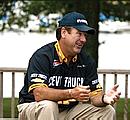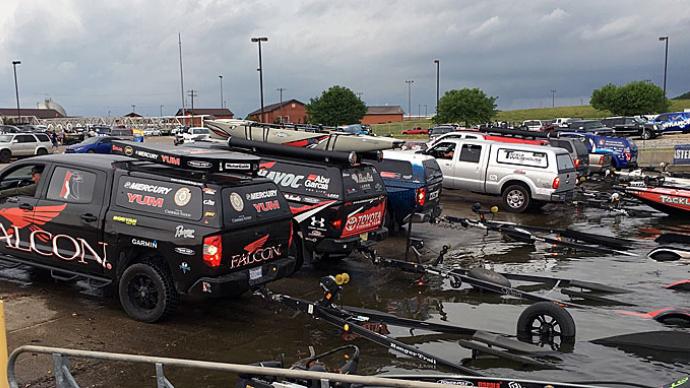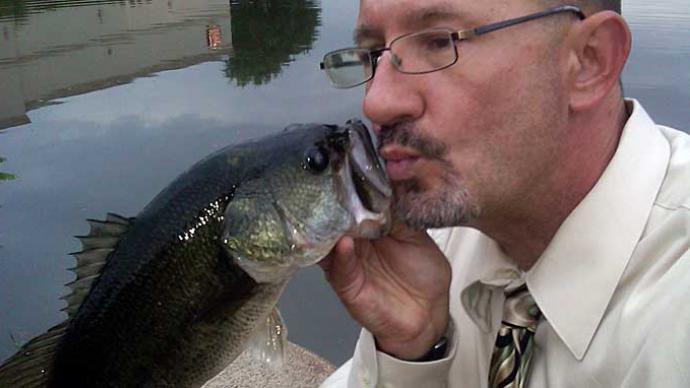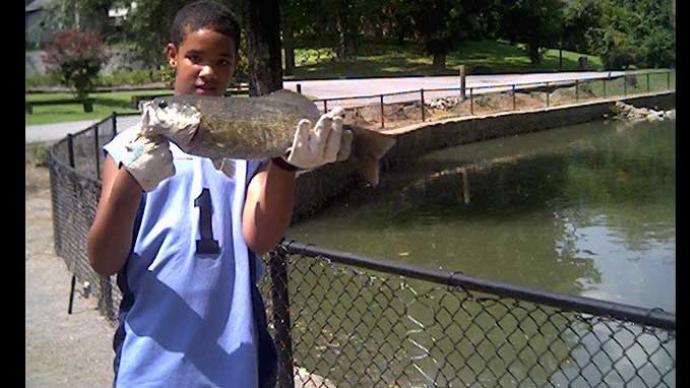| Propellers propel bass to bite. |
|
In bass fishing, anglers must learn to expect the unexpected. Sometimes, anglers find bass biting under the most unimaginable circumstances. Just ask Sam Swett, a Wal-Mart FLW Tour competitor from Covington, La. "One time in New York state, I was fishing down a rocky bank and catching an occasional fish," Swett said. "I approached a 100-car ferry docked on the bank with its engines running to keep it tight against the bank while it loaded. Because a cable stretched across the river, I couldn't move until the ferry got out of the way. It looked like good water on the other side, so I waited for the ferry to leave." Swett said that the powerful diesel engines driving the propellers vibrated the water around the ferry as they pushed it against the dock. As the giant propellers turned, they churned the bottom into a muddy soup. Current from the backwash pushed everything off the bottom in all directions. With little else to do, Swett continued casting into the maelstrom to pass the time. "I caught a 4-pound smallmouth on the first cast," he said. "On the second cast, I caught another one. Grass and trash were coming up from the bottom. I caught about 15 fish in successive casts. After the ferry left, I didn't get another bite." Swett continued fishing down the shoreline beyond the ferry landing as planned but found little action. When the ferry returned from its crossing, the fish started biting again. The professional angler didn't take long to latch upon this unusual pattern. "When the ferry returned, it started blowing up a lot of silt and bait," Swett said. "The smallmouths were in that current feeding on all the creatures disturbed by the ferry propellers. After it left, I went to the other side of the river, where the ferry docked again. The same thing happened. I started catching fish when the ferry started churning up the bottom again. I guess the fish had just become conditioned to know that they would find food every time they heard those engines. I couldn't believe how many fish I caught right by those ferry propellers that day." Swett collected a hefty tournament check because of his smallmouth serendipity. After years of studying why bass bite, they still surprise us. Now and then, try something different to see what happens. |

Every bass angler loves to fish on a pristine lake with clear, aquamarine waters and lush, flowering vegetation interspersed between fallen logs or a scenic river with pure water flowing along excellent shoreline cover.
That idyllic scene does sound tempting, but bass look at things differently. Anglers sometimes find bass around some of the ugliest or most unusual places - industrial docks, rusty sunken barges, rotten bulkheads, or even urban settings. Where humans see an eyesore of old rotting timber and rusty metal, bass see a promised land of feeding opportunities.
"To a bass, it doesn't get any better than a rusty pipe with barnacles," said Larry Nixon of Bee Branch, Ark., a veteran professional bass angler. "The only type of cover that looks ugly to me is a piece of slimy wood. Bass swim around slimy cover, but they don't rub against it. I like cover that's hard with a good edge."
Industrial areas may look ugly to people, but they offer everything bass need to survive - unless the water becomes too polluted. Bass near industrial docks or old rotting bulkheads find cover from predators and places where they can ambush prey. In addition, industrial structures offer current breaks and typically easy access to deep water where bass can escape temperature extremes.

Bulkheads and pilings usually protect shorelines from erosion in many shipping docks or industrial areas. In places like Philadelphia, Pa., or Camden, N.J., some wooden bulkheads date back decades, perhaps even more than a century, offering bass many places to feed.
"The bulkheads create some of the best fishing on the Delaware River," said Pete Gluszek, a professional bass angler from Franklinville, N.J. "Bass look for anything that creates current breaks. Minnows and baitfish flow in and out of these ambush points. An old ship prop might create many eddies that attract bass. An old, broken, pushed-out bulkhead makes a great feeding ground for bass. Crawfish and bluegills get in there, and bass go after them."
Many people think of bulkheads as flat surfaces, but they can contain various types of cover. Individual pilings might stick out a bit farther than others. Horizontal support beams keep bulkheads together and provide additional cover. A leaning plank or broken timber creates a current break attracting fish. Corners provide cover in multiple directions. Anglers should try to key in any abnormalities or subtle differences.
A loading dock might protrude a bit farther out into a ship channel. These can provide cover at several points. Sometimes, floating debris snags on dock pilings and creates more cover. Old concrete blocks that have tumbled into the water can provide unlimited ambush points.
Often, bulkheads at shipping docks might face extremely deep water. Water might drop to more than 50 feet. Bass do not necessarily hide near the bottom; they frequently suspend near the surface. To catch bass along such deep vertical cover, anglers need to fish baits that dive to where bass suspend without going to the bottom.
A spinner bait or crankbait run parallel to bulkheads makes an effective presentation. Position your boat nearly against a bulkhead and throw baits upstream. Then work them downstream. The most aggressive bass typically face upstream, looking for targets of opportunity to wash toward them.
"I make a lot of vertical presentations with soft-plastic baits," Gluszek said. "I pitch finesse worms and jigs. Most fish suspend at about 10 feet deep or less because that's where most of the food is. So I pitch a finesse worm against the bulkhead and count for about five seconds. Then I work it about a foot or two off the wall."
Gluszek rigs a finesse worm with a 1/16- to 1/4-ounce jighead with an exposed hook. He throws the bait next to a bulkhead and works it parallel down the wall erratically. Occasionally, he pauses to let it sink 10 or 12 feet before continuing to retrieve it.
Many old barges tied to bulkheads eventually sink. Owners abandon them to rot away. An old barge or sunken towboat can form an artificial reef and attract bunches of bass. Old spars and ribs may stick out like flooded timber. Compartments create holes or cover where fish can hide; they are excellent places to throw spinnerbaits.
Sunken barges might also mark the edge of a channel. Silt usually builds on one side while currents scour holes on the other side. This provides opportunities to fish in both shallow and deep water. Usually, currents ripping around a partially sunken barge dredge a deep trough parallel to the metal. Fish drop into such channels. Observe how the current hits the structure to find sweet spots that might hold fish.
Floating barges also attract fish, and docked towboats might still house crews. Sometimes, towboat crews toss leftovers or other food tidbits over the side, attracting baitfish. Bass congregate where baitfish gather.
Baitfish also gather near warm-water discharge pipes in huge numbers. In addition, Shad and other baitfish feed on plankton or other tiny organisms in the water, and bass come to feed at the baitfish buffet.
Industrial or urban areas frequently offer opportunities to target fish that few people consider catching. Bass in these areas might die of old age without seeing many lures. On the other hand, fish from ugly water might make a beautiful catch - and an even more beautiful check in a tournament!
Content provided by Bass Fishing Magazine, the official publication of FLW Outdoors




